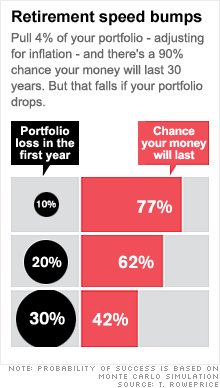Make sure you don't outlive your cash
Traditional income strategies assume that retirement will be smooth and steady. It never is.

(Money Magazine) -- Before the market imploded last year, turning your nest egg into steady income for 30 or more years of retirement seemed pretty straightforward. Just follow the old 4% rule: Withdraw that much of your portfolio's value initially and then boost that dollar amount annually for inflation.
But as I've pointed out in this column and online, the 4% rule has two big problems. If your investments thrive, you could end up with a huge balance, meaning you lived more frugally than you had to. On the other hand, if your portfolio suffers a steep loss, especially early on in retirement, the odds of your money running out can soar. This risk, no doubt, has become painfully clear.
So how should you turn your 401(k)s and other retirement accounts into spendable income? Here are two steps that you can take to increase your odds of living as well as you can without ending up with too little money.
There's no single percentage that guarantees the best results. But if you want your money to last at least 30 years, you should probably begin with an initial withdrawal of between 4% and 5%. You can take out more, of course, but you'll boost the odds that your money won't last throughout the length of your retirement, or that you may have to settle for a lower level of spending in the future.
How much you pull from your nest egg going forward, though, should be tied to its value. That way "you're adjusting your consumption to reflect your resources," says John Ameriks of Vanguard's Investment Counseling & Research Group.
In other words, if your portfolio has taken a hit, think about scaling back your planned withdrawals. The extent to which you do that will depend on the losses. If the damage is minor, you may be able to manage just by forgoing an inflation boost for a few years. If the hit is substantial, you may need to actually reduce the amount you withdraw.
Conversely, when the markets are doing well and your portfolio's value is climbing, don't be afraid to raise the amount you withdraw.
How often should you make such changes to your income plan? Think about revisiting your strategy every year or so, just as you would rebalance your portfolio annually.
Thankfully, there's technology that can help. Go to T. Rowe Price's Retirement Income Calculator and plug in your account value, your age, and how much you're planning to spend annually in retirement. You'll get an estimate of your probability of success.
If your prospects are uncomfortably low - or have fallen from last year - rerun the numbers with lower withdrawal amounts. If your chances are still good - or if they've risen from last year - see if you can afford to boost spending.
Granted, this isn't as straightforward as the 4% rule. But life doesn't unfold as neatly as a spreadsheet.
Want a Money Makeover? E-mail us at makeover@moneymail.com. ![]()


